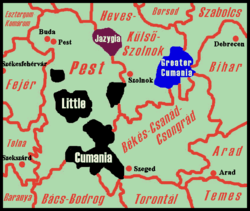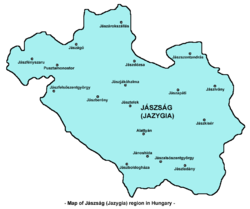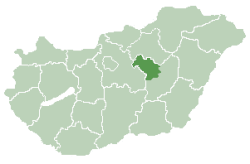Jasz people
The Jász are an Iranic ethnic group who have lived in Hungary since the 13th century. They live mostly in a region known as Jászság, which comprises the north-western part of Jász-Nagykun-Szolnok county. Jász is the Hungarian name, and Jasz the English exonym for the community, also known by endonyms Iasi or Jassy. They originated as an Ossetian (Alani) people from Sarmatia.
| Total population | |
|---|---|
| 200,000 | |
| Regions with significant populations | |
| Hungary (in the Jászság region within the Jász-Nagykun-Szolnok County) | |
| Languages | |
| Hungarian (Uralic, Finno-Ugric) and formerly Jasz (Indo-European, Iranian) | |
| Religion | |
| Roman Catholic | |
| Related ethnic groups | |
| Ossetians and other Iranian people |
Geography

The cultural and political center of Jászság is the town of Jászberény.
Jászság is sometimes, erroneously, known as "Jazygia", after a somewhat related Sarmatian people, the Iazyges, who lived in a similar area in ancient times. However, there is no direct connection between the Jász and Iazyges.
History
The Jasz people were a nomadic Sarmatian (or Scythian) tribe which settled in the medieval Kingdom of Hungary during the 13th century[1] and are generally thought to be of Ossetian origin originally speaking a dialect of the Ossetic language. The dialect is extinct and members of the Jász usually speak Hungarian.
Their name is almost certainly related to that of the Iazyges, one of the Sarmatian tribes which, along with the Roxolani, reached the borders of Dacia during the late 1st century BC (the city of Iași is named for them). Residual elements of these tribes, ancestors of the Jasz people, remained behind in the central North Caucasus, mingling with Caucasian peoples to form the present-day Ossetes.
The Jasz people came to the Kingdom of Hungary, together with the Cumanians (Hungarian: Kun people) when their lands to the east, in some in the later Moldavia (see Iași and Jaszvasar) were invaded by the Mongol Empire in the mid-13th century. They were admitted by the Hungarian king, Béla IV Árpád, who hoped that the Jaszs would assist in resisting the Mongol-Tatar invasion. Shortly after their entry, the relationship worsened dramatically between the Hungarian nobility and the Cumanian-Jasz tribes, which then abandoned the country. After the end of the Mongol-Tatar invasion they returned and settled in the central part of the Pannonian Plain, near the rivers Zagyva and Tarna.

Initially, their main occupation was animal husbandry. During the next two centuries, they were fully assimilated into the Hungarian population;[1] their language disappeared,[1] but they preserved their Jasz identity. The Hungarian rulers granted the Jasz people special privileges. Thus, the Jasz were able to be more or less self-governing in an area known as Jászság in which Jászberény developed into the regional, cultural and administrative center.
In the 16th–17th centuries, areas populated by the Jasz people were under Ottoman administration, but at the end of the 17th century they were recaptured and returned to the Kingdom of Hungary, which was then part of the Habsburg Monarchy. Habsburg Emperor Leopold I sold the area to the Knights of the Teutonic Order. This saw the end of the privileged position of Jászberény. However, the Jasz people did not want to accept this situation and started to collect money with which they could buy their freedom. By 1745, they had collected half a million Rhenish gold florins, a considerable sum for those days. However, in this time the famous 'Act of Redemption' took place: the Empress Maria Theresa restored the Jasz land and Jasz hereditary privileges. From this point onwards, Jaszberény flourished. The Jasz regional autonomy was preserved until the year 1876, when area populated by the Jasz was administratively included into the Jász-Nagykun-Szolnok County.


After dissolution of Austria-Hungary in 1918, areas populated by the Jasz people were included into an independent Hungary. Over a dozen settlements in the Great Hungarian Plain (e.g. the names Jászberény, Jászárokszállás, Jászfényszaru, Jászalsószentgyörgy) still include a link to the Jasz. In 1995, the 250th Anniversary of the Act of Redemption was celebrated in Jászberény with the President of Hungary as guest of honor as well as with numerous foreign dignitaries.
Language
Jassic is the common name in English for the original language of the Jász. It is dialect of Ossetian and, therefore, the broader Iranian language family. Jassic became extinct and was replaced by Hungarian. The only literary record of the Jász language was found in the 1950s in the Hungarian National Széchényi Library. The language was reconstructed with the help of various Ossetian analogies.
Notable people of Jassic descent
See also
- Jasz dialect
- Ossetians
- Alans
- Hungarians
- Jászság
- Jász-Nagykun-Szolnok
- Iași/Jassy
- Székelys
- Saka
- Scythians
References
- Frederik Coene, The Caucasus: an introduction, Taylor & Francis, 2009, p. 219
- https://hvg.hu/sport/20130804_Jasz_az_pedig_kemeny_fajta__Orban_Csanyi